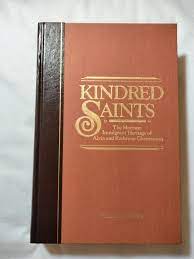Articles/Essays – Volume 16, No. 4
Saints You Can Sink Your Teeth Into | William G. Hartley, Kindred Saints: The Mormon Immigrant Heritage of Alvin and Kathryn Christensen
With us, someone else’s genealogy ranks right up there with reading the tele phone directory or watching someone else’s home movies. Most Mormon family histories are about as much fun as funerals. Thus, it was with an onerous sense of duty to DIALOGUE that we agreed to review Kindred Saints, a family genealogy of people we had never even heard of. But Skip Christenson, modern kin of the kindred saints, must have been as weary as we of family histories where all the baptisms are performed through the same hole chopped in the same ice, where sea gulls appear on cue out of thin air, and great-grandfather’s saintly capacity for get ting along perfectly with all five wives is exceeded only by their ability to get along with each other. The Christenson family tried a novel approach to writing a family history; they hired a professional historian. William G. Hartley has created something a notch above family history cliches—readable history which delivers the Chris tenson ancestors to us as they actually were.
Leonard Arrington, writes the intro duction, underlining the focus of Kindred Saints on commonplace pioneer experience:
Brigham Young needed the Kindred Saints. When he selected the Great Basin to be the place for members of the Church of Jesus Christ of Latter-day Saints to build a godly society, he needed the Corlesses, Christensons, Crowthers, Schlesselmanns, and others like them, to provide muscle to make raw lands productive, develop businesses and industries, infuse spirituality and decency in LDS communities, rear Christian children, be good neighbors, and staff and fund the church’s varied programs.
These families aren’t famous, even in Church circles. But we could identify with these representatives of the human foundation upon which Mormonism was built. We could envision our ancestors rubbing shoulders with these convert-emigrants on Liverpool’s gigantic docks where Nathaniel Hawthorne observed humans “as numerous as maggots in cheese.” We could yearn with them for the travel orders from Perpetual Emigration officials to flee the “de cadence and apostasy of the wicked world,” our eyes fixed with theirs on “the distant land of Zion” (p. 261).
“For all immigrants,” according to Hartley, “immigration was a traumatic experience, resulting in a sense of alienation and isolation” (p. 154). Kindred Saints recreates the experience, pressing beyond cliche to detail. That experience included, for example, the seasickness that plagued the hardiest of travelers. A candid observer of the Britannia saw emigrants “seize hold of a tin bowl or slop pail and heave all they had within out of them and when that was done they did not appear satisfied with this but would again heave, heave, heave” (p. 271).
Hartley details the hardships. The streets of Zion were not paved with gold but sagebrush. Streams had to be dammed, irrigation ditches dug, drought, flood, and grasshoppers had to be faced. The kindred Saints were poorly trained to deal with the harshness of the land. In the old country, they had been tailors, herdsmen, and cobblers. In the new land, people wrestled directly with nature. Thomas Corless, for example, a farmer in 1880 Salt Lake was typical:
His eyes searched, like a doctor his patient, the leaves and stalks for signs of disease or insects, their kernels and heads for plumpness, the ditches for clogs or erodings, the heavens for signs of frost or rain. His ears enjoyed the familiar smooth swishing of sharp scythes swinging through the rustling grain, the lowing of cows in the barn, the whinnying and snorting of hitched and corralled horses, the scratches and cackles from the backyard chicken coops, the waters sloshing through canal sluice-gates, the squish of sloppy mud beneath damp boots, and the crack of axe-split logs. His body felt sweat in his hatbands, stiffness in his perspiration caked gloves, juicy blisters between hand and hoe handle, chapped lips cracked by dry summer breezes, shoulder shuddering chills from snow-peppered winter winds, and the tickle of fat black flies visiting from his barnyard. His mouth and nose knew the rich taste of thick white milk still warm from the cow, cool and tin bucket-flavored water draw from the Corless spring, teeth grit from dusty roads and fields, and the offensive backyard odors of cow, horse, and chicken manure, (p. 85)
Much of Kindred Saints gives us as much as this passage. Thomas Corless did not leave a personal account of what it was like to take a deep breath of barnyard air or a quick gulp of water from a tin bucket. But Hartley shows us what it was like. His fleshing out of detail is what makes Kindred Saints work. We grieve with the family who found their little daughter in the creek “both little hands clinging on to the long grass on the side of the creek, but she was drowned” (p. 48). We share the righteous anger of Fort Limhi missionaries who “drew up a list of Indians” that had just slain three Mormons, and “excommunicated the baptized ones on the list” (p. 81). We identify with the faith of the Kindred Saints, their determination to drive ahead into the future, their desire to leave the world in better condition.
Kindred Saints is clearly out of the mainstream of Church history; it will not meet the expectations of those looking for prominent events in the Mormon past. But Hartley’s insistent detail manages to make these unknown saints feel kindred to us. Mormons thinking of writing a family his tory will find in Kindred Saints an admirable model.
Kindred Saints: The Mormon Immigrant Heritage of Alvin and Kathryne Christenson by William G. Hartley (Salt Lake City: Eden Hill Publishing, 1982), 530 pp., $25.


 Back to full Issue
Back to full Issue

